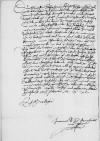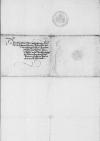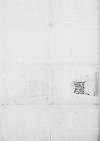 GStA PK, HBA, C1 No 638 1 unnumbered
GStA PK, HBA, C1 No 638 1 unnumbered
Durchlauchter(r), hochgeborner(r) furst, / hochgunstiger(r), vilgeliebter(r) her(r) und freundt. / Mein freuntlich un(n)d gancz vleiswillige dienste zuvoran(n). /
Gestriges tags hab ich E(wer) F(urstlichen) D(urchlauch)t ⌊⌋ entfangen(n), do neben(n) die brive in vorgenomen(en) sachen(n) an mein(n) alten(n) hoffbruder(r), den(n) ⌊Nibschicz⌋, / welche ich mit andren(n) meinen(n) morgen(n) frwe im wil zuschicken(n), / zu Gote hoffende, das sie mit meynem(m) boten(n) wol und gewislich sollen(n) zwstelle komen(n). / Mein schreiben(n) sol ouch, / wie ich im written over , written over n⌈nm(m)m written over , written over n⌉ negsten(n) gemelt, / an die II h(e)rn etc. ausghen(n) etc.
Vor das freuntlich entpitten(n) / der durchlaucht(en), hochgeborn(en) E(wer) F(urstlichen) D(urchlauch)t ⌊furstin⌋ und herczog Hansen(n) thue ich mich gen ire f(urstliche) d(urchlauch)t beyde uffs hochst bedancken(n) / und bleib im vorigen(n) wunschen(n), Goth den hochsten(n) bittende, Ew(e)r und ire f(urstliche) d(urchlauch)t(en) in seiner gnaden(n) / vor allem written over n⌈nmm written over n⌉(m) argen, / und das seele un(n)d leib widrig ist, zu behutten(n) und bewaren(n), / und thue mich hiemit in E(wer) F(urstlichen) D(urchlauch)t grosse und erkante gunst mith hochem vleis vortraulich befelen(n), / der ich mich mit al meynem(m) vormugen(n) genczlich in aller freuntlicher(r) zuvorsicht / ergebe willig und gehorsam(m).
E(wer) F(urstlichen) D(urchlauch)t williger(r)
⌊Ioannes⌋, etc. b(ischoff) zu ⌊Ermeland⌋ etc. ma(n)u p(ro)pria etc.
 GStA PK, HBA, C1 No 638 4 unnumbered
GStA PK, HBA, C1 No 638 4 unnumbered  GStA PK, HBA, C1 No 638 1 unnumbered
GStA PK, HBA, C1 No 638 1 unnumbered 


